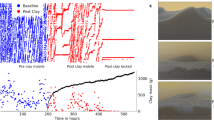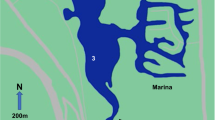Abstract
The movement of fluvial sediment shapes our rivers. Understanding sediment entrainment has been a goal of hydraulic engineers for almost a century1,2. Previous sediment entrainment models have been informed by laboratory experiments using grains that were free from biological material3. In natural river settings, however, sediments are invariably covered by bacteria, often forming visible biofilms, which comprise diverse consortia of species housed in sticky extracellular polysaccharides. Here we report experiments in a laboratory flume with cyanobacteria grown over sediment. We show that the prevailing model, where grains roll over one another at some critical threshold in shear velocity, does not hold for biofilm-bound sediments. Instead, biostabilized sediment behaves more like an elastic membrane. Fluid flow produces oscillations in the membrane, which can become unstable. Beyond a particular threshold in velocity, the membrane fails catastrophically by ripping and clumps of biofilm-bound sediment become entrained. We use a mathematical model of an oscillating membrane in incompressible flow to show that unstable oscillations will occur over a wide range of elastic material properties at realistic river flow velocities. We find that the horizontal length scale over which oscillations occur is a controlling factor for incipient sediment entrainment of biostabilized sediments.
This is a preview of subscription content, access via your institution
Access options
Subscribe to this journal
Receive 12 print issues and online access
$259.00 per year
only $21.58 per issue
Buy this article
- Purchase on Springer Link
- Instant access to full article PDF
Prices may be subject to local taxes which are calculated during checkout




Similar content being viewed by others
References
Gilbert, G. K. The Transportation of Debris by Running Water (United States Geological Survey, 1914).
Shields, A. Application of Similarity Principles and Turbulence Research to Bed-load Movement (US Dept. of Agr., Soil Conservation Service Cooperative Laboratory, California Institute of Technology, 1936).
Gomez, B. & Church, M. An assessment of bed load sediment transport formulae for gravel bed rivers. Wat. Resour. Res. 25, 1161–1186 (1989).
Grant, J. & Gust, G. Prediction of coastal sediment stability from photopigment content of mats of purple sulfur bacteria. Nature 330, 244–246 (1987).
Black, K. S., Tolhurst, T. J., Paterson, D. M. & Hagerthey, S. E. Working with natural cohesive sediments. J. Hydraul. Eng.-Asce 128, 2–8 (2002).
Paterson, D. M. in Cohesive Sediments (eds Burt, N., Parker, R. & Watts, J.) 215–229 (1997).
Garcia-Pichel, F. & Wojciechowski, M. F. The evolution of a capacity to build supra-cellular ropes enabled filamentous cyanobacteria to colonize highly erodible substrates. PLoS ONE 4.11, e7801 (2009).
Bathurst, J. C. Effect of coarse surface layer on bed-load transport. J. Hydraul. Eng.-Asce 133, 1192–1205 (2007).
Wilhelm, L., Singer, G. A., Fasching, C., Battin, T. J. & Besemer, K. Microbial biodiversity in glacier-fed streams. Isme J. (2013) Early on line.
Lyautey, E., Lacoste, B., Ten-Hage, L., Rols, J. L. & Garabetian, F. Analysis of bacterial diversity in river biofilms using 16S rDNA PCR-DGGE: Methodological settings and fingerprints interpretation. Water Res. 39, 380–388 (2005).
Yalin, M. S. & Karahan, E. Inception of sediment transport. J. Hydraul. Div.-Asce 105, 1433–1443 (1979).
Vignaga, E. The Effect of Biofilm Colonization on the Stability of Non-cohesive Sediments. PhD thesis, Univ. Glasgow (2012).
Aggarwal, S., Poppele, E. H. & Hozalski, R. M. Development and testing of a novel microcantilever technique for measuring the cohesive strength of intact biofilms. Biotechnol. Bioeng. 105, 924–934 (2010).
Xu, F., Billingham, J. & Jensen, O. E. Divergence-driven oscillations in a flexible-channel flow with fixed upstream flux. J. Fluid Mech. 723, 706–733 (2013).
Benjamin, T. B. Shearing flow over a wavy boundary. J. Fluid Mech. 6, 161–205 (1959).
Miles, J. W. On the generation of surface waves by shear flows. J. Fluid Mech. 3, 185–204 (1957).
Benjamin, T. B. Effects of a flexible boundary on hydrodynamic stability. J. Fluid Mech. 9, 513–532 (1960).
Davies, C. & Carpenter, P. W. Instabilities in a plane channel flow between compliant walls. J. Fluid Mech. 352, 205–243 (1997).
Huang, W. Z. & Sloan, D. M. The pseudospectral method for solving differential eigenvalue problems. J. Comp. Phys. 111, 399–409 (1994).
Liu, H. F., Luo, X. Y. & Cai, Z. X. Stability and energy budget of pressure-driven collapsible channel flows. J. Fluid Mech. 705, 348–370 (2012).
Taherzadeh, D. et al. Computational study of the drag and oscillatory movement of biofilm streamers in fast flows. Biotechnol. Bioeng. 105, 600–610 (2010).
Rippka, R., Deruelles, J., Waterbury, J. B., Herdman, M. & Stanier, R. Y. Generic assignments, strain histories and properties of pure cultures of cyanobacteria. J. Gen. Microbiol. 111, 1–61 (1979).
Grabowski, R. C., Droppo, I. G. & Wharton, G. Erodibility of cohesive sediment: The importance of sediment properties. Earth-Sci. Rev. 105, 101–120 (2012).
Acknowledgements
W.T.S. is an Engineering and Physical Sciences Research Council (EPSRC) UK Advanced Research Fellow and this research was supported by EPSRC grants EP/F007868/1 and EP/D073693/1 and Natural Environment Research Council grant NE/D522211/1.
Author information
Authors and Affiliations
Contributions
E.V. conducted the experimental research; E.V., H.H., V.R.P. and W.T.S. planned the experiments; X.L., D.M.S. and W.T.S. formulated the mathematics; D.M.S. was responsible for the numerics; W.T.S. undertook the computing and W.T.S. and D.M.S. wrote the paper.
Corresponding author
Ethics declarations
Competing interests
The authors declare no competing financial interests.
Supplementary information
Supplementary Information
Supplementary Information (PDF 856 kb)
Supplementary Movie S1
Supplementary Movie S1 (WMV 15103 kb)
Supplementary Movie S2
Supplementary Movie S2 (WMV 8894 kb)
Supplementary Movie S3
Supplementary Movie S3 (WMV 1191 kb)
Rights and permissions
About this article
Cite this article
Vignaga, E., Sloan, D., Luo, X. et al. Erosion of biofilm-bound fluvial sediments. Nature Geosci 6, 770–774 (2013). https://doi.org/10.1038/ngeo1891
Received:
Accepted:
Published:
Issue Date:
DOI: https://doi.org/10.1038/ngeo1891
This article is cited by
-
Experimental study on pollution release and sediment scouring of sewage sediment in a drainage pipe considering incubation time
Environmental Science and Pollution Research (2023)
-
Models of bed-load transport across scales: turbulence signature from grain motion to sediment flux
Stochastic Environmental Research and Risk Assessment (2023)
-
The role of shear dynamics in biofilm formation
npj Biofilms and Microbiomes (2022)
-
Biological effects on incipient motion behavior of sediments with different organic matter content
Journal of Soils and Sediments (2021)
-
Understanding streambeds as complex systems: review of multiple interacting environmental processes influencing streambed permeability
Aquatic Sciences (2020)



